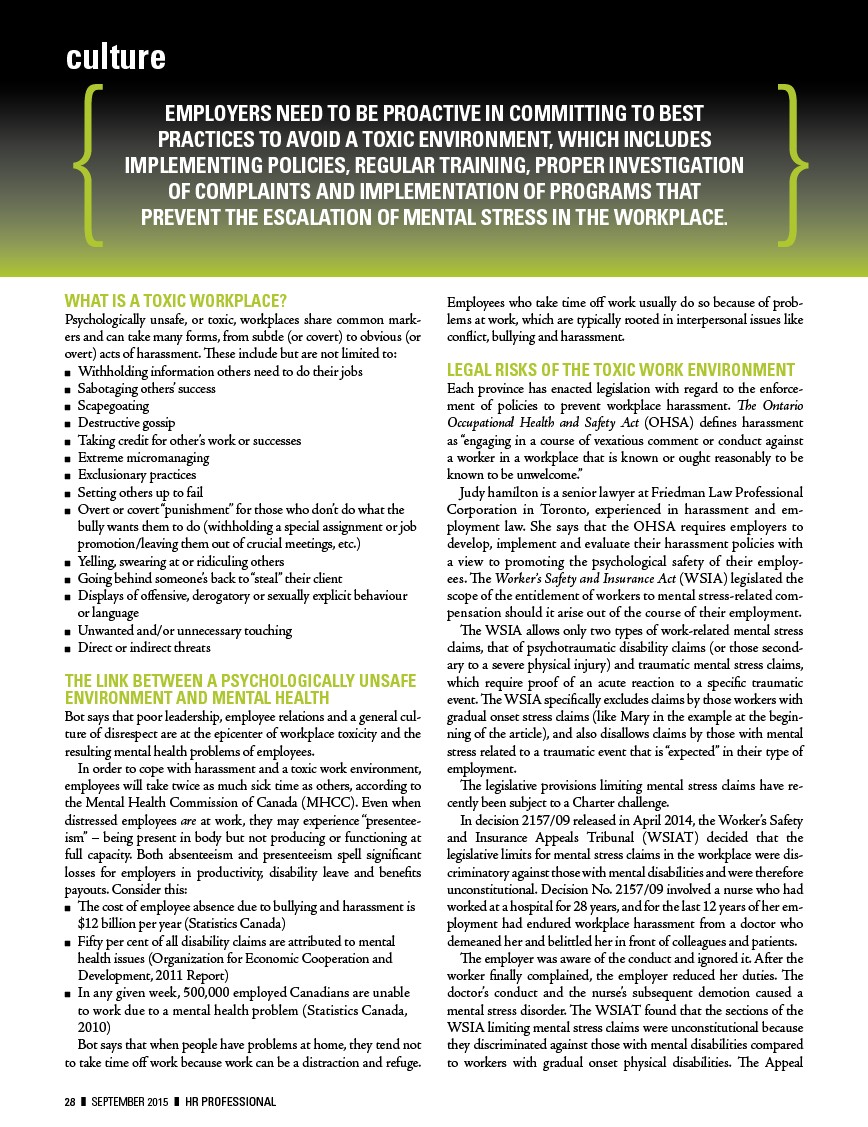
WHAT IS A TOXIC WORKPLACE?
Psychologically unsafe, or toxic, workplaces share common markers
and can take many forms, from subtle (or covert) to obvious (or
overt) acts of harassment. These include but are not limited to:
■■ Withholding information others need to do their jobs
■■ Sabotaging others’ success
■■ Scapegoating
■■ Destructive gossip
■■ Taking credit for other’s work or successes
■■ Extreme micromanaging
■■ Exclusionary practices
■■ Setting others up to fail
■■ Overt or covert “punishment” for those who don’t do what the
bully wants them to do (withholding a special assignment or job
promotion/leaving them out of crucial meetings, etc.)
■■ Yelling, swearing at or ridiculing others
■■ Going behind someone’s back to “steal” their client
■■ Displays of offensive, derogatory or sexually explicit behaviour
or language
■■ Unwanted and/or unnecessary touching
■■ Direct or indirect threats
THE LINK BETWEEN A PSYCHOLOGICALLY UNSAFE
ENVIRONMENT AND MENTAL HEALTH
Bot says that poor leadership, employee relations and a general culture
of disrespect are at the epicenter of workplace toxicity and the
resulting mental health problems of employees.
In order to cope with harassment and a toxic work environment,
employees will take twice as much sick time as others, according to
the Mental Health Commission of Canada (MHCC). Even when
distressed employees are at work, they may experience “presenteeism”
– being present in body but not producing or functioning at
full capacity. Both absenteeism and presenteeism spell significant
losses for employers in productivity, disability leave and benefits
payouts. Consider this:
■■ The cost of employee absence due to bullying and harassment is
$12 billion per year (Statistics Canada)
■■ Fifty per cent of all disability claims are attributed to mental
health issues (Organization for Economic Cooperation and
Development, 2011 Report)
■■ In any given week, 500,000 employed Canadians are unable
to work due to a mental health problem (Statistics Canada,
2010)
Bot says that when people have problems at home, they tend not
to take time off work because work can be a distraction and refuge.
Employees who take time off work usually do so because of problems
at work, which are typically rooted in interpersonal issues like
conflict, bullying and harassment.
LEGAL RISKS OF THE TOXIC WORK ENVIRONMENT
Each province has enacted legislation with regard to the enforcement
of policies to prevent workplace harassment. The Ontario
Occupational Health and Safety Act (OHSA) defines harassment
as “engaging in a course of vexatious comment or conduct against
a worker in a workplace that is known or ought reasonably to be
known to be unwelcome.”
Judy hamilton is a senior lawyer at Friedman Law Professional
Corporation in Toronto, experienced in harassment and employment
law. She says that the OHSA requires employers to
develop, implement and evaluate their harassment policies with
a view to promoting the psychological safety of their employees.
The Worker’s Safety and Insurance Act (WSIA) legislated the
scope of the entitlement of workers to mental stress-related compensation
should it arise out of the course of their employment.
The WSIA allows only two types of work-related mental stress
claims, that of psychotraumatic disability claims (or those secondary
to a severe physical injury) and traumatic mental stress claims,
which require proof of an acute reaction to a specific traumatic
event. The WSIA specifically excludes claims by those workers with
gradual onset stress claims (like Mary in the example at the beginning
of the article), and also disallows claims by those with mental
stress related to a traumatic event that is “expected” in their type of
employment.
The legislative provisions limiting mental stress claims have recently
been subject to a Charter challenge.
In decision 2157/09 released in April 2014, the Worker’s Safety
and Insurance Appeals Tribunal (WSIAT) decided that the
legislative limits for mental stress claims in the workplace were discriminatory
against those with mental disabilities and were therefore
unconstitutional. Decision No. 2157/09 involved a nurse who had
worked at a hospital for 28 years, and for the last 12 years of her employment
had endured workplace harassment from a doctor who
demeaned her and belittled her in front of colleagues and patients.
The employer was aware of the conduct and ignored it. After the
worker finally complained, the employer reduced her duties. The
doctor’s conduct and the nurse’s subsequent demotion caused a
mental stress disorder. The WSIAT found that the sections of the
WSIA limiting mental stress claims were unconstitutional because
they discriminated against those with mental disabilities compared
to workers with gradual onset physical disabilities. The Appeal
culture
EMPLOYERS NEED TO BE PROACTIVE IN COMMITTING TO BEST
PRACTICES TO AVOID A TOXIC ENVIRONMENT, WHICH INCLUDES
IMPLEMENTING POLICIES, REGULAR TRAINING, PROPER INVESTIGATION
OF COMPLAINTS AND IMPLEMENTATION OF PROGRAMS THAT
PREVENT THE ESCALATION OF MENTAL STRESS IN THE WORKPLACE.
28 ❚ SEPTEMBER 2015 ❚ HR PROFESSIONAL